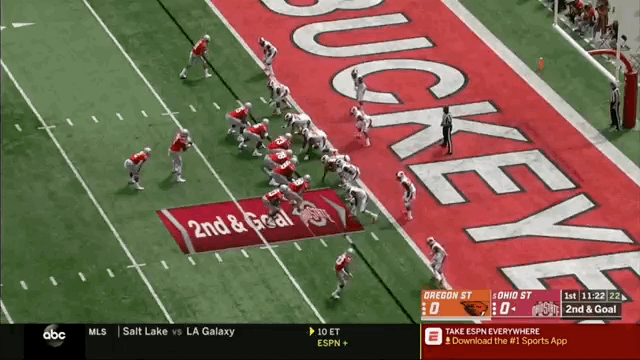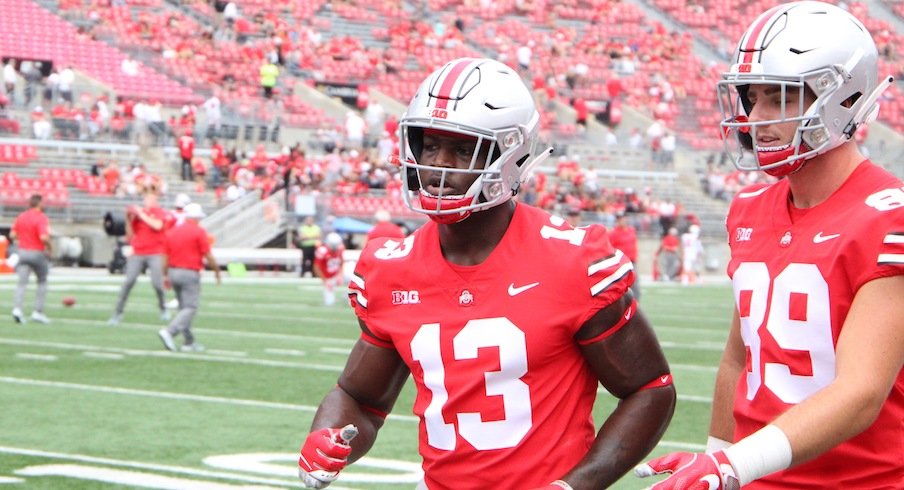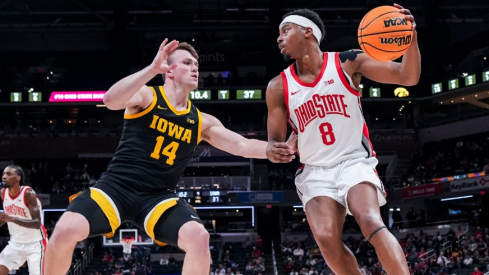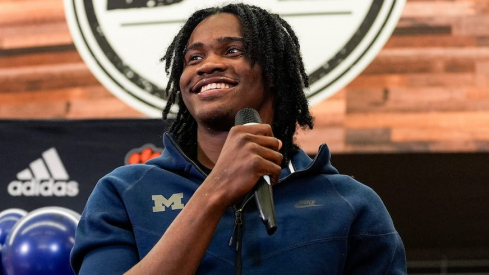In the first half of Saturday’s season opener against Oregon State, Ohio State ran three offensive plays in which it had two tight ends on the field simultaneously. All three of those plays resulted in touchdowns.
Facing 2nd-and-goal at the 2-yard line on their first possession of the game, the Buckeyes put both Luke Farrell and Rashod Berry on the right side of the line – drawing the Oregon State defense in expecting a run play – and wide receiver Terry McLaurin beat single coverage on a route across the end zone to catch a touchdown from Dwayne Haskins.

On 1st-and-goal from the 6-yard line on their third possession of the game, the Buckeyes deployed a different two-tight end formation – this time with Berry on the left side of the line, and Farrell on the right – and it resulted in a touchdown once again, as Berry ran a pattern to the right side of the field that got him open for a catch from Haskins and enabled him to stroll in for a touchdown.

Facing 3rd-and-goal at the 3-yard line on their fifth possession of the game, the Buckeyes put “22” personnel – that being when both two running backs and two tight ends are on the field simultaneously – into the game, and that resulted in a touchdown, too. Farrell and Berry both lined up on the right side once again, J.K. Dobbins lined up to Haskins’ right and Mike Weber – who initially lined up wide on the left side – motioned in front of Haskins, caught a pop pass from him and ran behind blocks from Berry, Farrell and Dobbins to the end zone.

Ohio State’s standard offensive formation puts three wide receivers on the field, with one tight end and one running back, and with a deep group of wide receivers that’s loaded with talent – including six who played regularly last season and should continue to this season – it typically makes sense for the Buckeyes to have at least three of them on the field per play.
Those three first-half touchdown plays on Saturday, though, showed why it also makes sense for the Buckeyes to sometimes mix it up.
In a game in which it ran 88 total offensive plays, Ohio State ran 12 total plays in which it had two tight ends on the field against Oregon State, more than in any single game last season.
Ohio State offensive coordinator and tight ends coach Kevin Wilson hinted at the possibility that the Buckeyes could use more multi-tight end sets this season when he last met with the media at the conclusion of spring practices.
“I like that a lot. Not because it’s my guys, but I like it when you can go from 12 (personnel) and still spread out. In a perfect world, when you can move guys around, it puts a lot of stress on the defense,” Wilson said. “We did it more this spring than we did last year.”
Fellow Ohio State offensive coordinator and current acting head coach Ryan Day said Tuesday during the Big Ten coaches’ teleconference that the increased use of two-tight end sets is made possible by the depth the Buckeyes feel they have at the position – Farrell and Berry both played regularly in the season opener, while true freshman Jeremy Ruckert also saw some playing time with the first-team offense in his debut – but said he feels the Buckeyes have many different offensive formations they can use from game to game.
“It presents a different look to the defense,” Day said of using two-tight end sets. “So you present different personnel groupings, that’s one more thing for a defense to work on. So it presents a different way to attack them. So we’re looking at all those things … and figuring out what grouping at that time gives us the best situation to be successful, and try to create more conflict to the defense, more to prepare for.”
“When you can move guys around, it puts a lot of stress on the defense.”– Ohio State offensive coordinator and tight ends coach Kevin Wilson
Ohio State’s reputation in recent years has been that it hasn’t thrown regularly to its tight ends, and that might not change even if the Buckeyes use more two-tight end sets this year. Out of 25 combined pass completions by Haskins and Tate Martell on Saturday, Berry’s touchdown catch was one of only two receptions by tight ends; Ruckert had one catch when Martell and the backups were in during the fourth quarter, while Farrell didn’t have any catches despite playing the most snaps among tight ends.
With a group of playmakers at wide receiver that includes Parris Campbell, K.J. Hill, Austin Mack, Terry McLaurin, Johnnie Dixon and Binjimen Victor, the outside receivers are still likely to see the vast majority of targets this season.
Using two tight ends in certain situations, though, perhaps particularly in the red zone, is a wrinkle that can make the Buckeyes offense more multi-faceted in both the passing and running games, and give defenses more to prepare for, and they’ll have reason to consider using them even more after yielding immediate results from them in the season’s first game.


